|
|
|
Sort Order |
|
|
|
Items / Page
|
|
|
|
|
|
|
| Srl | Item |
| 1 |
ID:
191529


|
|
|
|
|
| Summary/Abstract |
Although originating in Algeria, AQIM and its allies had by 2012 become so entrenched in the Sahel that they were in de-facto control of vast swathes of territory in northern Mali. This article explains how and why GSPC/AQIM established itself in the Sahel, and why the group eventually decided to take the fight to the Sahelian countries, where they had previously found sanctuary. Relying on hitherto unused primary sources, this article is the first to show that the leadership of AQIM and al-Qaida Central did not want to engage in direct conflicts with the Sahelian states. The eventual shift of strategy in the region was brought about by the increasing numbers of Sahelians in AQIM's southern brigades.
|
|
|
|
|
|
|
|
|
|
|
|
|
|
|
|
| 2 |
ID:
191530


|
|
|
|
|
| Summary/Abstract |
This article analyses how counter terrorism policing before and after the August 2017 jihadi attacks in Catalonia was negatively affected by two factors: the Spanish policing model based on a decentralized security system and the independentist challenge posed by the Catalan Government. Firstly, the article assesses the political and legal framework vis-à-vis security in a quasi-federal democracy like Spain. Secondly, it analyzes how the police response to the jihadist threat was impacted by this multilayer system structured around a central government, seventeen autonomous regions, two autonomous cities, and over eight thousand local councils. Thirdly, the article examines how the challenge posed by independentists in the Autonomous region of Catalonia, who in 2017 attempted to break away from Spain in defiance of the Spanish Constitution, exacerbated the structural problems of the security system. It concludes that the combination of several factors in a particularly conflictive political environment led to the failure of counter terrorism policing on three levels: proactive, preventive, and reactive.
|
|
|
|
|
|
|
|
|
|
|
|
|
|
|
|
| 3 |
ID:
191525
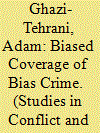

|
|
|
|
|
| Summary/Abstract |
News media differentially cover violence based on social identity. How does media bias apply to terrorist attacks—typically “upward crimes” where perpetrators hold less power than targets—that are also hate crimes—typically “downward crimes”? We compare coverage of incidents that are both terrorist attacks and hate crimes to coverage of incidents that are just terrorism in the U.S. from 2006 to 2015. Attacks that are also hate crimes receive less media attention. Articles are more likely to reference hate crimes when the perpetrator is unknown and more likely to reference terrorism when the perpetrator is non-white in some models.
|
|
|
|
|
|
|
|
|
|
|
|
|
|
|
|
| 4 |
ID:
191544


|
|
|
|
|
| Summary/Abstract |
The article focuses on causes of violent extremism in Kazakhstan by looking at the violent attacks on law-enforcement bodies in 2011 and 2016 in Aqtobe, Almaty, and Atyrau. Drawing on interviews with the convicted extremists, we argue that criminal youth subculture, grievances, the Salafi-jihadist ideology, and propaganda in the Internet have promoted extremist violence in Kazakhstan. We also make a brief comparative analysis of European jihadists and violent extremists in Kazakhstan, highlighting some important similarities and differences across the regions.
|
|
|
|
|
|
|
|
|
|
|
|
|
|
|
|
| 5 |
ID:
191518
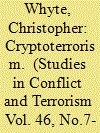

|
|
|
|
|
| Summary/Abstract |
Much recent policy discourse has pivoted on the relationship between terrorist campaigns and an emergent feature of the global financial landscape in the form of cryptocurrencies. Cryptocurrencies are a subset of digital currencies that are distributed by the developers thereof. The various unique features of cryptocurrencies have led to discussion in punditry about how terrorists could benefit from this new mode of financial transaction but few policy-oriented works and scholarly assessments exist to outline and assess this claim. This article describes cryptocurrencies, and assesses them in line with the operational realities of terrorist campaigns. I argue that, while there is limited evidence that terrorists are likely to disproportionately benefit from use of cryptocurrencies at present, there do exist unique opportunities for money laundering and revenue generation.
|
|
|
|
|
|
|
|
|
|
|
|
|
|
|
|
| 6 |
ID:
191522


|
|
|
|
|
| Summary/Abstract |
When the Knights Templar cartel targeted the people of Michoacán, vigilantes formed for protection. This study uses a paired sample t-test to investigate the effect that the emergence and subsequent removal of the vigilantes and their confrontational approach against the Knights Templar had on cartel-related crimes. Initially, homicides increased in vigilante areas, while kidnappings and extortions decreased. After vigilantes were removed, homicides and kidnappings increased, while extortions decreased. Government removal of vigilantes allowed for a power vacuum to ensue, allowing violence to increase. Therefore, violence initially increases with vigilante presence, then decreases, while increasing again once the group is removed.
|
|
|
|
|
|
|
|
|
|
|
|
|
|
|
|
| 7 |
ID:
191546


|
|
|
|
|
| Summary/Abstract |
Why does China view its Turkic Muslims as a security threat? Although scholars have written a good deal on China’s repression of minorities, the number of empirical studies about China’s ever-expanding incarceration and surveillance of Turkic Muslims is rather limited. To identify the reasons for China’s repressive policies, this article draws evidence from Xinjiang Victims Database that presents video testimonies of 8973 people whose family members and friends are in China’s prisons and detention camps. The evidence shows that China’s policies stem from a constructivist securitization approach where religion, culture and identity play central roles although the country frames its policies through a realist discourse on terrorism and security.
|
|
|
|
|
|
|
|
|
|
|
|
|
|
|
|
| 8 |
ID:
191527


|
|
|
|
|
| Summary/Abstract |
Policymakers sometimes argue that material assistance to rebels involved in a civil war can create a ‘ripe moment’ that is favorable for negotiations. Ripeness theory provides support for this idea. However, this notion has never been systematically assessed. This article evaluates this claim by using global data on negotiations in all intrastate armed conflicts from 1975 to 2009. Contrary to popular belief, the article demonstrates that external state support to rebel groups does not increase the prospect of negotiations. Instead, the results suggest that external support is likely to reduce the likelihood of negotiations between the warring parties, especially if the state sponsor is a great power. The study contributes to our understanding of civil war processes by demonstrating that military assistance hinders rather than promotes the onset of negotiations and by questioning the utility of ripeness theory as the most suitable framework for understanding this phenomenon.
|
|
|
|
|
|
|
|
|
|
|
|
|
|
|
|
| 9 |
ID:
191534


|
|
|
|
|
| Summary/Abstract |
This explorative study presents some theoretical reflections on the influence that family may exert in the context of Islamist radicalization. In doing so, a new preliminary framework consisting of four levels of analysis is introduced and its relevance illustrated using examples from the Palestinian, Indonesian, Chechen and, more broadly, Western context. If sufficiently adaptive, the proposed framework may not only raise the analyst’s awareness of the “bigger picture” in which family’s influence on radicalization should be investigated. It can also serve as a useful analytical model to uncover certain trends and characteristics of family’s attitudes toward terrorism in specific contexts, rendering the framework valuable from both a theoretical and practical analysis.
|
|
|
|
|
|
|
|
|
|
|
|
|
|
|
|
| 10 |
ID:
191514


|
|
|
|
|
| Summary/Abstract |
This article offers an analysis of women’s profiles, pathways, and motivations to join the Lebanese civil war (1975 to 1990), with a particular focus on female fighters militants involved with Harakat Amal, Kataeb, the Progressive Socialist Party, Lebanese Communist Party, Fatah and the Popular Front for the Liberation of Palestine. The article contributes to existing debates on women’s motivations to join nonstate armed groups by examining both militias that included female fighters and those that did not. It is the first study so far that analyses the profiles and motivations of female fighters and militants within all major militias during the Lebanese civil war.
|
|
|
|
|
|
|
|
|
|
|
|
|
|
|
|
| 11 |
ID:
191521


|
|
|
|
|
| Summary/Abstract |
Using a countering violent extremism program as a case study, this article highlights the conceptual and practical challenges for meaningful inclusion of gender in security programing. Gender mainstreaming is commonly cited as a goal for stakeholders. Unfortunately, the security framework under which many counterterrorism programs are implemented and the general lack of understanding around the complexity of gender has often led to failures for meaningful inclusion in program design and evaluation. This article argues that a gender-sensitive approach is needed for effective countering violent extremism programing and counterterrorism policy, therefore is needed to create a more secure world for all individuals.
|
|
|
|
|
|
|
|
|
|
|
|
|
|
|
|
| 12 |
ID:
191519


|
|
|
|
|
| Summary/Abstract |
How do Norwegian government officials perceive the dilemma between liberty and security after the 2011 terrorist attacks? A survey from 2016 shows that the central government officials’ attitudes are rather similar to the general population. Both are willing to trade individual rights for more societal security. Structural, cultural, and demographic features explain variations in the civil servants’ views. Position and perceptions of crisis management capacity make a difference. Officials responsible for crisis management are more willing to prioritize security. Low conflict, high trust, and a strong identification with central government creates support for security measures. Furthermore, age and gender matter.
|
|
|
|
|
|
|
|
|
|
|
|
|
|
|
|
| 13 |
ID:
191548
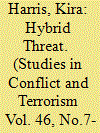

|
|
|
|
|
| Summary/Abstract |
Hybrid threat actors are dynamic and often intentionally disguise their intentions. While the Russian motorcycle club Night Wolves dress comparably to outlaw motorcycle gangs, open source materials describe the club as posing a distinctly different national security threat. The Night Wolves’ ambiguity and covert activities make the club hard to analyze; however, this case study uses open source materials to provide insight into their activities and characteristics across an array of security domains. International incidents indicate members and associates have the capability and resources to engage in crime, corruption and politically-motivated violence both for personal interests, as well as the furtherance of Russian goals.
|
|
|
|
|
|
|
|
|
|
|
|
|
|
|
|
| 14 |
ID:
191524


|
|
|
|
|
| Summary/Abstract |
This paper examines the under-studied area of innovation and terrorism. Beyond exploring the debate on the difference between creativity and innovation and how it impacts terrorist groups, the paper also reviews the typology of terrorist innovation and of the law of unintended consequences. The presence of terrorist groups in the online gaming world is an example of creativity and innovation as the groups recognize that counterterrorist policies have limited their ability to communicate with potential recruits. Consequently, extremists have had to find new avenues to communicate with supporters and attract potential recruits as they are determined to survive. Security agencies must also ensure that they are also thinking ‘outside the box’ as only through creativity can they stay one-step ahead of their adversaries.
|
|
|
|
|
|
|
|
|
|
|
|
|
|
|
|
| 15 |
ID:
191513
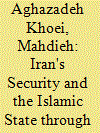

|
|
|
|
|
| Summary/Abstract |
After the Cold War, a new generation of security studies emerged that moved debates beyond traditional, narrow, state-centric definitions of security toward considering other aspects like economic, political, social, and environmental contexts. This article evaluates one such contemporary important security concern—the threat of the Islamic State (IS), mainly against Iran, in the framework of the Copenhagen School security approach. The analysis concludes that IS threatens Iran's security by increasing the possibility of Kurdish sectarianism, widening the Shi’ite–Sunni gap, creating economic threats, decreasing Iran's influence in Syria, and challenging its power in the region. Analyzing Iran's stance against IS and the ensuing security debate is important to predict the future of the Middle East.
|
|
|
|
|
|
|
|
|
|
|
|
|
|
|
|
| 16 |
ID:
191543


|
|
|
|
|
| Summary/Abstract |
This paper employs a mixed-method approach to explore the criminal nexus of Islamist militant groups operating in Bangladesh. Data for 98 (14%) of 710 militants profiled in this study suggest various types of criminal involvement. By blending a qualitative social network analysis of top leaders from four militant groups, we find a much better picture of how terrorists pursue the strategies of appropriation, cooperation or transformation in developing criminal nexus. Findings also reveal the organizational level at which terrorists interact with criminals, and the processes through which they use marketplace interactions, prison-based radicalization, and virtual crime-linkage to expand their operations.
|
|
|
|
|
|
|
|
|
|
|
|
|
|
|
|
| 17 |
ID:
191516


|
|
|
|
|
| Summary/Abstract |
What factors affect the likelihood that violent nonstate actors pursue and use chemical, biological, radiological, or nuclear (CBRN) weapons? What factors make a country at-risk for a CBRN terrorist attack? We argue that widespread repressive practices, also termed human rights abuses, are especially problematic in the fight to stop the pursuit or use of CBRN weapons. Repression by government forces severs ties between civilians and their government, leading those with knowledge of attacks to refrain from turning over necessary information. We test our argument quantitatively using data from the Big Allied and Dangerous Project and the Global Terrorism Database. Our results highlight how efforts taken to limit the use of repression may be an effective strategy to reduce risks of CBRN terrorism.
|
|
|
|
|
|
|
|
|
|
|
|
|
|
|
|
| 18 |
ID:
191542
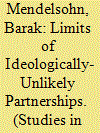

|
|
|
|
|
| Summary/Abstract |
Why did Syria collaborate with al-Qaeda’s Iraqi branch after 2003 and with ISIS during the Syrian civil war? States’ support for terrorist groups is risky, but cooperation with jihadi actors who see the Syrian regime as an enemy and wish to impose a radical Islamic rule in its stead is particularly dangerous. This paper argues that such ideologically-unlikely partnerships reveal the workings of the instrumental logic behind state-sponsored terrorism. Collaborating with terrorist groups is a rational strategy. States such as Syria will partner with ideologically-incompatible terrorist groups when they judge there to be a greater and more urgent threat from a third actor; when they believe the partnership would give them unique capabilities or produce special, otherwise unattainable effects; and when they believe they can shield themselves from the relationship’s potential adverse effects. The Syrian case also shows that such a pairing is likely to have limited utility. In order to have meaningful impact, the terrorist group must have a significant role, but the greater this role is, the higher the direct danger the group poses to its ally and the greater the likelihood of international action against the sponsoring state.
|
|
|
|
|
|
|
|
|
|
|
|
|
|
|
|
| 19 |
ID:
191538


|
|
|
|
|
| Summary/Abstract |
The counterterrorism and CVE community has long questioned the effectiveness of counterspeech in countering extremism online. While most evaluation of counterspeech rely on limited reach and engagement metrics, this paper explores two models to better measure behavioral change and sentiment analysis. Conducted via partnerships between Facebook and counter-extremism NGOs, the first model uses A/B testing to analyze the effects of counterspeech exposure on low-prevalence-high-risk audiences engaging with Islamist extremist terrorist content. The second model builds upon online safety intervention approaches and the Redirect Method through a search based “get-help” module, redirecting white-supremacy and Neo-Nazi related search-terms to disengagement NGOs.
|
|
|
|
|
|
|
|
|
|
|
|
|
|
|
|
| 20 |
ID:
191531


|
|
|
|
|
| Summary/Abstract |
Debates over the relationship between natural resources and armed conflicts have flourished in the past two decades, but few studies have considered the case of oil and the Islamic State in Iraq and Syria. This paper reviews key scholarly arguments concerning the relationship between natural resources and armed groups, and examines the interrelationship between oil, armed conflict and ISIS. Building on this analysis, the paper offers insights into dilemmas of oil dependence for non-state armed groups controlling proto-states: specifically, while oil enabled ISIS to consolidate its attempts at establishing a de facto state, it also created vulnerabilities. Among these, U.S.-led forces deliberately targeted oil to deny ISIS’ attempts to achieve statehood, and to politically confine its status to that of a terrorist organization ruling over an oil rich and dangerous proto-state targeted for military and political eradication. These findings point to the value of nuanced analyses of relations between resource wars arguments and terrorism studies, as well as the need to more broadly consider the various political dimensions of natural resources in the study of armed conflicts and campaigns against terrorist organizations.
|
|
|
|
|
|
|
|
|
|
|
|
|
|
|
|
|
|
|
|
|